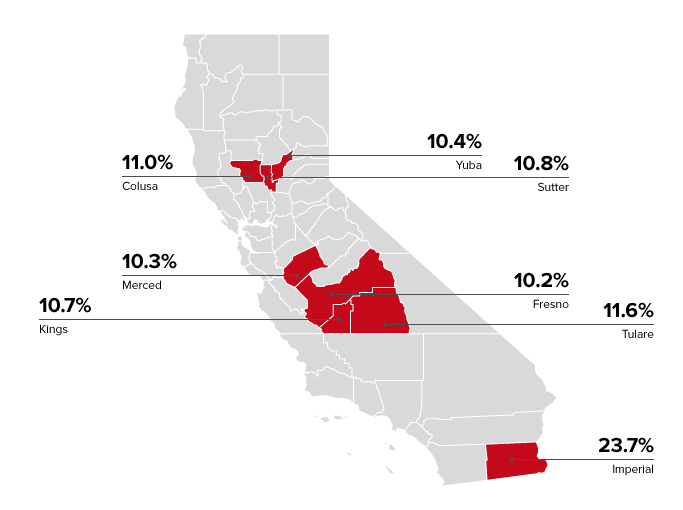Highlights for policy makers:
- Unemployment Rate Improves to 7.3%; Total Employment Climbs 89,800
- Labor Force Participation Rate Remains at 1976 Levels
- 1/5 of Total Employed in Part Time Work
- Nonfarm Jobs Increase 41,500
- 7 Industries Remain Below 2007 Pre-Recession Job Levels; 12 Above
- 8 Counties Remain in Double-Digit Unemployment, Up from 6 in September
- Two-Tier Economy Persists
- 2013 County & Regional Personal Income Data Available
Unemployment Rate Remains Constant at 7.3%; Total Employment Climbs 89,800
The Labor Force data for October 2014 (seasonally adjusted; California preliminary) is shown below, along with the change from the prior month:
The related not seasonally adjusted numbers (California preliminary), with the change from October 2013:
California Employment Development Department’s (EDD) latest release shows on a seasonally adjusted basis, total employment grew by 89,800, while the number of unemployed dropped by only 1,300. California’s seasonally adjusted unemployment rate remained constant at 7.3%. The unadjusted rate increased from 6.9% in September 2014 to 7.0% in October 2014.
By comparison, total US employment grew 2.6% (seasonally adjusted increase of 683,000), while the number of unemployed decreased even more sharply by 2.9% (seasonally adjusted decrease of 267,000).
California’s seasonally adjusted unemployment rate now stands 26% higher than the national rate. California had the 5th highest unemployment rate among the states.
Between October 2013 and October 2014, Bureau of Labor Statistics (BLS) data shows the total number of employed increased by 556,022 (not seasonally adjusted). This increase was the highest among the states, ahead of Texas (399,074) and Florida (340,193). Adjusted for population size, California had the 15th highest employment increase (18.5 additional employed per 1,000 population), with DC (38.4 per 1,000 population), Colorado (31.2 per 1,000 population), and North Dakota (29.1 per 1,000 population) in the leading slots.
Labor Force Participation Rate Remains at 1976 Levels
The state’s seasonally adjusted labor force participation rate of 62.3% ticked upward for the 2nd month in a row, but still remains at levels last seen in 1976.
1/5 of Total Employed in Part Time Work
The percentage of part time workers increased slightly to 20.2% of total employment, with 7.1% working part time for economic reasons (primarily the lack of full time jobs).
Nonfarm Jobs Increase 41,500
EDD reported that between September and October 2014, seasonally adjusted nonfarm payroll jobs increased by 41,500. Not seasonally adjusted, nonfarm payroll jobs grew by 156,800.
Looking at the not seasonally adjusted numbers, the change in nonfarm payroll jobs from September 2014 saw the largest increases in Government (76,200), Educational Services (28,700), Retail Trade (19,600), and Health Care & Social Assistance (14,300). Biggest declines were in Manufacturing (-9,800), Accommodation & Food Services (-3,400), Arts, Entertainment & Recreation (-1,800), and Real Estate, Rental & Leasing (-1,200).
7 Industries Remain Below 2007 Pre-Recession Job Levels; 12 Above

Comparing the number of jobs by industry in October 2014 (seasonally adjusted), 7 industries remain below the 2007 pre-recession levels and 12 are above. As indicated in the figure above, growth has been primarily in the lower wage and higher wage industries. Significant job growth in industries paying above $1,000 a week average wage has been limited to Professional, Scientific & Technical Services and Management of Companies & Enterprises. All other industries in this wage category remain near or significantly below the 2007 average employment levels.
8 Counties Remain in Double-Digit Unemployment, Up from 6 in September

Two-Tier Economy Persists
Unemployment rates and employment (all data is not seasonally adjusted) continue to vary widely across the state, with the spread between regions increasing to 1.98.
By County:
Ratio of Highest to Lowest Rate: 6.08
By Legislative District:
Ratio of Highest to Lowest Rate: Senate 3.07
2013 County & Regional Personal Income Data Available
The Economic Indicators have been updated with the 2013 County and Region personal income data, along with the revised data for 2001-2012 recently released by US Bureau of Economic Analysis.
The data shows the income side of California’s continuing two-tier economy. By County, all of the counties with the 5 highest Per Capita Personal Incomes are in the Bay Area. The ratio of counties with the highest to lowest Per Capita Income in 2013 was 3.15, improved from 3.43 in 2007.
County Per Capita Personal Income
Considered by region, the Per Capita Personal Income level tracks with employment, with the coastal employment centers showing the highest per capita incomes. The ratio of regions with the highest to lowest per capita personal incomes was 2.01 in 2013, up from 1.91 in 2007.
